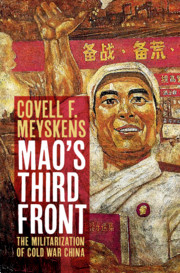Book contents
- Mao’s Third Front
- Mao’s Third Front
- Copyright page
- Contents
- Tables
- Figures
- Maps
- Abbreviations
- Acknowledgements
- Introduction
- 1 The Coming of the Third Front Campaign
- 2 Good People and Good Horses Go to the Third Front
- 3 Concentrating Forces to Wage Wars of Annihilation
- 4 Produce First and Consume Later
- 5 Industrial Development amid Cold War Insecurity
- Epilogue: The Demilitarization of Chinese Socialism
- Appendix: Third Front Demographics
- Bibliography
- Index
4 - Produce First and Consume Later
Published online by Cambridge University Press: 24 April 2020
- Mao’s Third Front
- Mao’s Third Front
- Copyright page
- Contents
- Tables
- Figures
- Maps
- Abbreviations
- Acknowledgements
- Introduction
- 1 The Coming of the Third Front Campaign
- 2 Good People and Good Horses Go to the Third Front
- 3 Concentrating Forces to Wage Wars of Annihilation
- 4 Produce First and Consume Later
- 5 Industrial Development amid Cold War Insecurity
- Epilogue: The Demilitarization of Chinese Socialism
- Appendix: Third Front Demographics
- Bibliography
- Index
Summary
Chapter 4 chronicles everyday life in the first Third Front project that Mao proposed – the steel town of Panzhihua in southern Sichuan. I demonstrate that Maoist ideas about how to build Chinese socialism profoundly impacted daily affairs in Panzhihua. In accordance with Maoism’s productivist ethos, officials focused on increasing production and building high-tech industry. Workers, meanwhile, were housed for years in barracks-style tents and provided with minimal consumer goods. Many Panzhihua residents did not experience the austerity of everyday life in ways that the Party considered appropriate to a good Maoist subject. Some recruits did not accept the CCP’s expectation that they be satisfied with building socialism wherever the Party decided was best. Others tired of their hectic work schedule and were bored with Panzhihua’s limited cultural life. Urban recruits desired to be with family in distant locations and move to a city higher up in socialist China’s socioeconomic order. Rural folk also wished to be with family but in contrast to urbanites they considered gaining access to the welfare provisions of a state–owned enterprise to be a route out of rural poverty. On both sides of the urban–rural divide, practices of daily life became the contested ground of Maoist developmentalism.
Keywords
- Type
- Chapter
- Information
- Mao's Third FrontThe Militarization of Cold War China, pp. 165 - 200Publisher: Cambridge University PressPrint publication year: 2020

